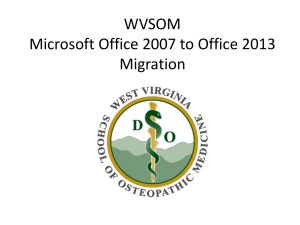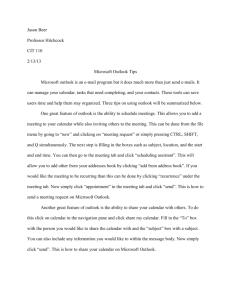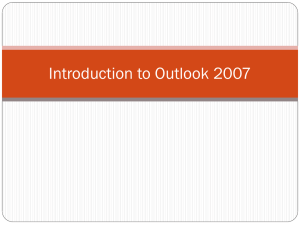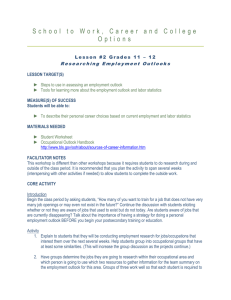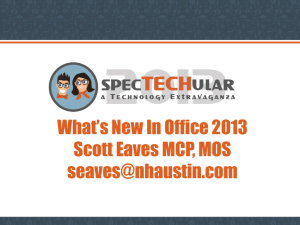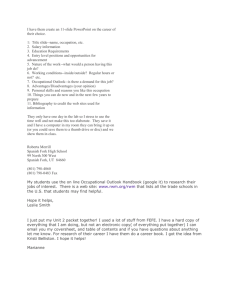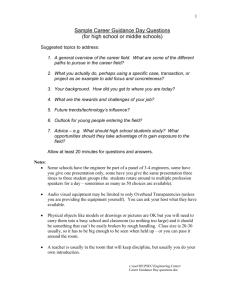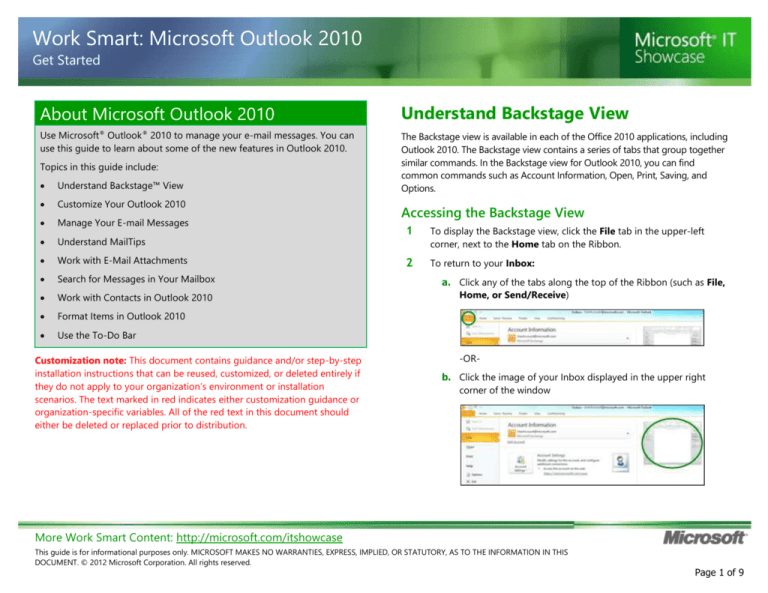
Work Smart: Microsoft Outlook 2010
Get Started
About Microsoft Outlook 2010
Understand Backstage View
Use Microsoft® Outlook® 2010 to manage your e-mail messages. You can
use this guide to learn about some of the new features in Outlook 2010.
The Backstage view is available in each of the Office 2010 applications, including
Outlook 2010. The Backstage view contains a series of tabs that group together
similar commands. In the Backstage view for Outlook 2010, you can find
common commands such as Account Information, Open, Print, Saving, and
Options.
Topics in this guide include:
Understand Backstage™ View
Customize Your Outlook 2010
Manage Your E-mail Messages
Understand MailTips
Work with E-Mail Attachments
Search for Messages in Your Mailbox
Work with Contacts in Outlook 2010
Format Items in Outlook 2010
Use the To-Do Bar
Customization note: This document contains guidance and/or step-by-step
installation instructions that can be reused, customized, or deleted entirely if
they do not apply to your organization’s environment or installation
scenarios. The text marked in red indicates either customization guidance or
organization-specific variables. All of the red text in this document should
either be deleted or replaced prior to distribution.
Accessing the Backstage View
1
To display the Backstage view, click the File tab in the upper-left
corner, next to the Home tab on the Ribbon.
2
To return to your Inbox:
a. Click any of the tabs along the top of the Ribbon (such as File,
Home, or Send/Receive)
-ORb. Click the image of your Inbox displayed in the upper right
corner of the window
More Work Smart Content: http://microsoft.com/itshowcase
This guide is for informational purposes only. MICROSOFT MAKES NO WARRANTIES, EXPRESS, IMPLIED, OR STATUTORY, AS TO THE INFORMATION IN THIS
DOCUMENT. © 2012 Microsoft Corporation. All rights reserved.
Page 1 of 9
Work Smart: Microsoft Outlook 2010
Get Started
Working with the Info Tab
The Info tab in the Backstage view contains many of the commands that
were located on the Tools menu in previous versions of Outlook.
•
Click Account Settings to modify your existing e-mail account or
configure a new e-mail account.
•
Click Automatic Replies (Out of Office) to configure your mailbox to
send automatic replies.
•
Click Mailbox Cleanup to manage the size of your mailbox and clean
up your Deleted Items folder.
•
Click Rules and Alerts to configure your mailbox to act on incoming
e-mail, such as organizing your mailbox by automatically moving
messages to a folder, or playing a sound when a message is received.
Customize Your Outlook 2010
You can use the features in Outlook 2010 to customize your Outlook experience
and make it easier to find messages. These features include using folders,
categories, flags, and a new feature in Outlook 2010 called Quick Steps.
Group Messages in Folders
You can organize your Outlook 2010 Inbox to create folders to group your
messages by topic, project, and sender.
1
On the Folder tab, click New Folder.
2
Type a name for the folder.
3
Select where you want to place the folder, and click OK. The new
folder appears in your list of mail folders.
4
Drag the messages you want into the new folder.
5
Repeat the process to create more folders.
Working with Outlook Options
You can click the Options tab to open the Outlook Options dialog box.
From this dialog box, you can perform many of the same types of tasks you
did using the Tools/Options menu in previous versions of Outlook, such as:
•
Click Mail to change settings for the messages you send and receive,
such as using Rich Text as your default message format.
•
Click Calendar to configure your calendar settings such as work hours,
days in your work week, and time zone settings.
•
Click Advanced to configure options for working with Outlook, such
as customizing the Outlook panes, configuring AutoArchive, and
configuring send and receive options.
Tip
Use the E-Mail Rules tool to route incoming messages automatically into
your folders. For more information, see section “Use E-Mail Rules to Route
Messages” later in this guide.
More Work Smart Content: http://microsoft.com/itshowcase
This guide is for informational purposes only. MICROSOFT MAKES NO WARRANTIES, EXPRESS, IMPLIED, OR STATUTORY, AS TO THE INFORMATION IN THIS
DOCUMENT. © 2012 Microsoft Corporation. All rights reserved.
Page 2 of 9
Work Smart: Microsoft Outlook 2010
Get Started
Use Quick Steps to Execute Common Commands in a
Single Click
3
Select from the list of common commands, or select Custom, and
then follow the prompts (similar to a Rules Wizard), to create a custom
action command.
4
Alternatively, you can modify an existing Quick Step if you find you do
not use it by right-clicking the step and then selecting Edit [name of
Quick Step].
A new feature in Outlook 2010, Quick Steps enables you to complete your
common tasks such as sending an e-mail message to the team with an
assigned task, responding with a meeting invitation, or automatically reply
and delete an e-mail, with a single click.
To Use a Predefined Quick Steps Command
1
Click on the Home tab and locate the Quick Steps group.
2
In the Quick Steps gallery, select a command from the predefined
commands.
Tip
To see all the commands in the Quick Steps gallery:
•
Click the Down arrow
to scroll through the command gallery.
•
Click the More arrow
to expand the command gallery.
To Create Your Own Quick Steps Commands
1
Click on the Home Ribbon tab and locate the Quick Steps group.
2
Click the More arrow
to display the Quick Steps dialog box, and
then click New Quick Step.
Manage Your E-mail Messages
You can use features such as the Conversation view and rules to make it
easier to manage your e-mail messages in Outlook 2010.
More Work Smart Content: http://microsoft.com/itshowcase
This guide is for informational purposes only. MICROSOFT MAKES NO WARRANTIES, EXPRESS, IMPLIED, OR STATUTORY, AS TO THE INFORMATION IN THIS
DOCUMENT. © 2012 Microsoft Corporation. All rights reserved.
Page 3 of 9
Work Smart: Microsoft Outlook 2010
Get Started
Use the Conversation View to Manage Your E-Mail
Messages
The Conversation view improves your tracking and managing of related email messages while saving valuable Inbox space, helping you manage large
amounts of e-mail with ease.
•
On the View tab, in the Conversations group, select Show as
Conversations to turn on Conversation view.
•
Click a conversation, and click
to expand the conversation
and reveal multiple messages about the same subject.
•
Right-click a conversation to categorize as “Important” or as
“Business” or flag it for “Follow Up.”
•
Right-click a conversation, select Ignore, and Outlook 2010 will
move those messages (and any subsequent replies to this
conversation) to the Deleted Items folder.
•
Right-click a conversation, select Clean Up Conversation, and
Outlook 2010 will remove duplicate messages in the
conversation.
•
Or, select the message, click on the Home tab, and choose your
action in the Delete group.
Tip
If a message you wanted to keep gets deleted, check your Deleted Items
folder for a copy of the message.
To Customize the Conversation Settings for a Folder
You can set the Conversation feature to display only messages in the folder
you have selected and not include messages in other folders that are part of
the conversation (the default setting). This makes it easier to ensure that,
when you clean up a conversation, you are not including messages that you
archived to another folder.
1
Select your folder.
2
Click the View tab, locate the Conversations group, click the More
arrow under the Conversation Settings button, and then select Show
Messages from Other Folders.
To Customize Conversation Clean Up
You can configure how the Conversation feature will clean up your e-mail
messages using Outlook Options in the Backstage view.
1
Click the File tab in the upper-left corner, next to the Home tab to
display the Backstage view.
More Work Smart Content: http://microsoft.com/itshowcase
This guide is for informational purposes only. MICROSOFT MAKES NO WARRANTIES, EXPRESS, IMPLIED, OR STATUTORY, AS TO THE INFORMATION IN THIS
DOCUMENT. © 2012 Microsoft Corporation. All rights reserved.
Page 4 of 9
Work Smart: Microsoft Outlook 2010
Get Started
2
In the Backstage view, click the Options tab to display the Outlook
Options dialog box.
3
Complete the information in the Create Rule dialog box, and then
click OK.
3
In the Outlook Options dialog box, click Mail, and then under
Conversation Clean Up, customize your settings.
4
To use the Rules Wizard to create your rule, click Advanced Options,
and then follow the instructions in the Rules Wizard. When you reach
the last page of the wizard, click Finish.
Reduce Unwanted Mail with Junk Filters
You can keep unwanted junk mail out of your Inbox by using Outlook Junk EMail filters. These filters send e-mail identified as junk to a separate mail
folder where you can later determine whether you want to delete it.
1
On the Home tab, in the Delete group, click the Junk list arrow, and
then select Junk E-Mail Options.
2
On the Options tab of the Junk E-mail Options dialog box, click a
protection level. Microsoft IT recommends using the High protection
level to provide the greatest protection.
Use E-Mail Rules to Route Messages
You can use Outlook 2010 E-Mail Rules to automatically route incoming and
outgoing messages based on criteria that you establish.
1
On the Home tab, in the Move group, click Rules. If you have more
than one e-mail account, make sure you have selected the Inbox to
which you want to apply the rule.
2
On the Rules list, click Create Rule.
More Work Smart Content: http://microsoft.com/itshowcase
This guide is for informational purposes only. MICROSOFT MAKES NO WARRANTIES, EXPRESS, IMPLIED, OR STATUTORY, AS TO THE INFORMATION IN THIS
DOCUMENT. © 2012 Microsoft Corporation. All rights reserved.
Page 5 of 9
Work Smart: Microsoft Outlook 2010
Get Started
Notes
Work with E-Mail Attachments
•
Review the Junk E-mail folder periodically to ensure that no legitimate
messages have been sent there. If they have, adjust the filter to avoid
flagging such messages in the future.
You can keep e-mail attachments with their original message for convenience.
However, to stay within mailbox size restrictions, you can also save e-mail
attachments to your computer or you can delete them.
•
Use other tabs in the Junk E-mail Options dialog box to add Safe
Senders, Safe Recipients, and Blocked Senders to your filter.
View and Save E-mail Attachments
Understand MailTips
1
Click a message with an attachment.
2
Click the attachment to preview it in the Reading Pane.
A new feature in Outlook 2010, MailTips alerts you when you are about to
send an e-mail message to a large distribution list, someone who is out of
office, or individuals outside the organization.
3
On viewing it, determine whether to keep the attachment with the
message, save it to your computer, or delete it:
You can use MailTips to:
•
Reduce the volume of e-mail by receiving alerts when someone is
unlikely to respond; for example, when their mailbox is full.
•
Avoid sending inappropriate information to a large distribution list.
•
Protect intellectual property from being sent outside of the organization.
•
To keep the attachment with the message, do nothing.
•
To save a single attachment to your computer, right-click the
title of the attached file, click Save As, browse to the location
where you want to save the attachment, and then click Save.
•
To save all attachments in the message to your computer, open
the message, click to select one of the attachments, and in the
Actions group on the Attachments tab, click Save All
Attachments, in the dialog box select which attachments you
want to save, click OK, browse to the location where you want
to save the attachment, and then click OK.
•
To remove an attachment, right-click it, and then click Remove
Attachment from the list.
By default, the MailTips bar is displayed automatically when MailTips apply.
Note
MailTips require Microsoft Exchange Server 2010.
More Work Smart Content: http://microsoft.com/itshowcase
This guide is for informational purposes only. MICROSOFT MAKES NO WARRANTIES, EXPRESS, IMPLIED, OR STATUTORY, AS TO THE INFORMATION IN THIS
DOCUMENT. © 2012 Microsoft Corporation. All rights reserved.
Page 6 of 9
Work Smart: Microsoft Outlook 2010
Get Started
Receive Voice Mail and Faxes
With Microsoft Exchange 2010 and Outlook 2010, you can receive voice mail
and faxes directly to your Inbox, and they can be accessed anywhere using
your computer, Outlook Mobile, or Outlook Web Access.
•
Click the attachment in your e-mail message to listen to your voice
mail message or view your fax.
•
View a transcript and other information in the e-mail message body.
Search for Messages in Your Mailbox
Tips
•
To narrow your search, type more than one word in the Search box.
•
To perform a more powerful search, explore the Search Tools tab to
select one or more options in the Refine group on the Search tab.
•
To perform an advanced search, click Search Tools in the Options
group on the Search tab in Search Tools, then click Advanced Find,
and enter additional search criteria in the Advanced Find dialog box.
•
After your search results appear, return to the regular e-mail window
by clicking Close Search in the Close group on the Search tab under
Search Tools.
Use the Outlook 2010 Search features to find a specific message in your
mailbox.
Use the Search Box to Find Messages
The Search box helps you find messages in your e-mail folders that contain
key words or phrases, or messages that meet other search criteria.
•
Click a folder in which to search, and in the Search box at the top of
the window, type one or more words. You do not need to press
ENTER, as the Search feature immediately begins looking for
messages that match your criteria.
Use Search Folders to Find Messages
Search Folders shows you where your mailbox stores messages that fall into
certain categories. There are three default Search Folders: Categorized Mail,
Large Mail, and Unread Mail.
•
•
Additionally, you can use other options to help narrow your search
keywords to specific criteria such as Keyword, From, and Subject.
In the Mail view, in the Mail pane, expand the Search Folders tree,
and then click one of the default Search Folders.
All messages in that category appear, as does the folder in which they
are stored.
Note
You can create new Search Folders for messages that do not fall into default
categories.
More Work Smart Content: http://microsoft.com/itshowcase
This guide is for informational purposes only. MICROSOFT MAKES NO WARRANTIES, EXPRESS, IMPLIED, OR STATUTORY, AS TO THE INFORMATION IN THIS
DOCUMENT. © 2012 Microsoft Corporation. All rights reserved.
Page 7 of 9
Work Smart: Microsoft Outlook 2010
Get Started
To create new Search Folders:
1
On the Folder tab, click New Search Folder.
2
In the New Search Folder dialog box, click a predefined Search
Folder, or scroll to the bottom of the dialog box and click Create a
Custom Search Folder.
3
Follow the instructions that appear.
•
Click the push pin icon to “pin” the Contact Card to the main
window to see presence status (colored bar to the left of contact’s
photo) and initiate communication with the contact.
•
Click the e-mail message
that person.
•
Or, click the balloon
icon or the phone
session or call the contact.
icon to open a new e-mail addressed to
icon to start an IM
Work with Contacts in Outlook 2010
Note
Outlook 2010 integration with Microsoft® Lync™ Online communications software
provides Outlook 2010 with two new features, Contact (hover) Cards and Quick
Contacts.
You must have Lync installed on the client to view presence status.
Understand Contact (hover) Cards
Outlook 2010 integration with Lync provides you access to your Lync
contacts directly from Outlook 2010 using the Quick Contacts feature.
You can use Contact (hover) Cards to search for and communicate with
people via instant message (IM), e-mail, or phone. You can also see photos of
your friends and colleagues in Outlook 2010 e-mail messages, contact cards,
and meeting requests.
Use Quick Contacts
•
Right-click in the To-Do Bar, click Options, and then select or clear
Show Quick Contacts.
You can display Contact (hover) Cards directly in your e-mail message to
IM, e-mail, or phone directly via Outlook 2010.
•
Point to a name in the e-mail thread to display a Contact (hover) Card.
More Work Smart Content: http://microsoft.com/itshowcase
This guide is for informational purposes only. MICROSOFT MAKES NO WARRANTIES, EXPRESS, IMPLIED, OR STATUTORY, AS TO THE INFORMATION IN THIS
DOCUMENT. © 2012 Microsoft Corporation. All rights reserved.
Page 8 of 9
Work Smart: Microsoft Outlook 2010
Get Started
Format Items in Outlook 2010
Format with Styles
You can use some of the features such as Microsoft SmartArt® graphics,
Tables, and Styles in Outlook 2010 to create more interesting looking e-mail
messages, contact notes, tasks, and appointment and meetings.
Insert SmartArt
1
Create a new item in Outlook 2010.
2
Highlight text in your new item, select the Format Text tab, and then
select a style from the Styles group.
3
Click the More arrow
to display more styles from which to choose.
1
Create a new item in Outlook 2010, such as an e-mail message or
meeting request.
Use the To-Do Bar
2
Select the Insert tab, and in the Illustrations group, select SmartArt.
3
In the Choose a SmartArt Graphic dialog box, select your choice
from the list, and then click OK.
You can use the Outlook 2010 To-Do Bar to keep track of your schedule and
tasks. The To-Do Bar features a small monthly calendar (called the Date
Navigator), an appointments list, and a task list.
Add Tables
You can perform many Outlook tasks from within the To-Do Bar, such as:
•
Accepting or declining a meeting by right-clicking a meeting request
in the appointments list, and then clicking Accept or Decline.
•
Opening a date on the Calendar by clicking on a date in the Date Navigator.
•
Flagging a message for follow up by dragging the message to the Task
List.
1
Create a new item in Outlook 2010.
For More Information
2
Select the Insert tab, and select Table.
3
In the Insert Table dialog box, drag to select the number of rows and
columns you want, and then click to create the table.
4
On the Table Tools Design tab, select formatting options to apply
formatting to your table.
Getting Started with Office 2010
http://office.microsoft.com/en-us/help/fx100646671033.aspx
More Work Smart Content: http://microsoft.com/itshowcase
This guide is for informational purposes only. MICROSOFT MAKES NO WARRANTIES, EXPRESS, IMPLIED, OR STATUTORY, AS TO THE INFORMATION IN THIS
DOCUMENT. © 2012 Microsoft Corporation. All rights reserved.
Page 9 of 9

